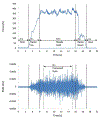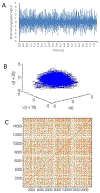Altered neuromuscular control in the vastus medialis following anterior cruciate ligament injury: A recurrence quantification analysis of electromyogram recruitment
- PMID: 36244098
- PMCID: PMC10958231
- DOI: 10.1016/j.clinbiomech.2022.105798
Altered neuromuscular control in the vastus medialis following anterior cruciate ligament injury: A recurrence quantification analysis of electromyogram recruitment
Abstract
Background: Neuromuscular deficits exist following anterior cruciate ligament (ACL) injury. To observe these deficits, we examined nonlinear characteristics of vastus medialis electromyography (EMG) signals during submaximal isometric knee extensor contractions. Our purpose was to examine if determinism and entropy in EMG signals reflected neuromuscular control deficits in individuals with ACL-deficient limbs.
Methods: 24 participants (12 male, 12 female, mean age = 18.8 ± 3.1 years) with unilaterally injured ACLs and 25 age-similar healthy controls (11 male, 14 female, mean age = 18.8 ± 3.1 years) volunteered. Isometric knee extensions were tested at 10%, 25%, 35%, and 50% maximum voluntary contractions. Surface electrodes adhered over the vastus medialis captured EMG signals. EMG data were processed with recurrence quantification analyses. Specifically, determinism (an index of system predictability) and entropy (an index of system disorder) were calculated from recurrence plots.
Findings: Determinism and entropy in EMG signals were lower in the injured than uninjured limb, and lower than that from healthy controls (P < .05).
Interpretation: Vastus medialis EMG signals from the injured limb were less predictable and less complex than those from healthy limbs. The findings reflect impaired neuromuscular control in the injured limb's quadriceps and are consistent with a 'loss of complexity' hypothesis in physiologic signals emanating from pathologic states. Determinism and entropy in EMG signals may represent biomarkers of one's neuromuscular control system.
Keywords: Anterior cruciate ligament; Electromyography; Entropy; Isometric contraction; Quadriceps muscle.
Copyright © 2022 Elsevier Ltd. All rights reserved.
Conflict of interest statement
Declaration of Competing Interest None of the authors has a financial or personal relationship with people or organizations that could inappropriately influence this work.
Figures




Similar articles
-
Recurrence quantification analysis of isokinetic strength tests: A comparison of the anterior cruciate ligament reconstructed and the uninjured limb.Clin Biomech (Bristol). 2023 Apr;104:105929. doi: 10.1016/j.clinbiomech.2023.105929. Epub 2023 Mar 3. Clin Biomech (Bristol). 2023. PMID: 36893524 Free PMC article.
-
Effects of anterior cruciate ligament injury on neuromuscular tensiomyographic characteristics of the lower extremity in competitive male soccer players.Knee Surg Sports Traumatol Arthrosc. 2016 Jul;24(7):2264-70. doi: 10.1007/s00167-014-3319-4. Epub 2014 Sep 25. Knee Surg Sports Traumatol Arthrosc. 2016. PMID: 25248310
-
Diminished neuromuscular system adaptability following anterior cruciate ligament injury: Examination of knee muscle force variability and complexity.Clin Biomech (Bristol). 2021 Dec;90:105513. doi: 10.1016/j.clinbiomech.2021.105513. Epub 2021 Oct 16. Clin Biomech (Bristol). 2021. PMID: 34695603 Free PMC article.
-
Differences in neuromuscular control and quadriceps morphology between potential copers and noncopers following anterior cruciate ligament injury.J Orthop Sports Phys Ther. 2014 Feb;44(2):76-84. doi: 10.2519/jospt.2014.4876. Epub 2013 Nov 21. J Orthop Sports Phys Ther. 2014. PMID: 24261930 Free PMC article.
-
Lower Limb Muscle Size after Anterior Cruciate Ligament Injury: A Systematic Review and Meta-Analysis.Sports Med. 2021 Jun;51(6):1209-1226. doi: 10.1007/s40279-020-01419-0. Epub 2021 Jan 25. Sports Med. 2021. PMID: 33492623
References
-
- Blasimann A, Koenig I, Baert I, Baur H, & Vissers D (2021). Which assessments are used to analyze neuromuscular control by electromyography after an anterior cruciate ligament injury to determine readiness to return to sports? A systematic review. BMC Sports Sci Med Rehabil, 13(1), 1–33. - PMC - PubMed
Publication types
MeSH terms
Grants and funding
LinkOut - more resources
Full Text Sources

